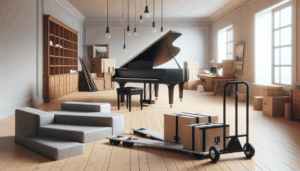At Utah Piano Movers, we understand that moving an Upright Piano can be a nerve-wracking experience. The potential for scratches, bumps, or even significant damage is a real concern for homeowners. That’s exactly why we’ve created this comprehensive guide. Our step-by-step approach will help you make this process as smooth and safe as possible. So, let’s dive in and give your piano the care it deserves.
Contents
- 1 Gathering the Right Equipment
- 2 Preparing Your Piano for the Move
- 3 Creating a Safe Pathway
- 4 Executing the Move with Precision
- 5 Navigating Stairs and Inclines
- 6 Loading the Piano into the Vehicle
- 7 Securing Your Piano for Transport
- 8 Unloading with Care
- 9 Post-Move Inspection and Adjustment
- 10 Why Choose Professional Help?
- 11 Contact Us for a Stress-Free Move
Gathering the Right Equipment
Before you begin the process, it’s crucial to collect the necessary moving tools. The right equipment makes all the difference in a successful move.
Firstly, you’ll need a sturdy moving dolly with straps to secure the piano. Without this, maneuvering the piano can be risky. You should also consider using protective blankets or pads to prevent scratches on the piano surface during transit. Lastly, having a team of strong helpers will ensure you have the muscle to move the piano safely. Remember, teamwork makes the dream work!
Preparing Your Piano for the Move
Now that you’ve got your equipment ready, it’s time to prepare your piano for the move. Proper preparation begins with assessing the piano’s current condition.
Carefully inspect your piano for any existing damage and take note of it. This could be an important reference point later. Next, close and securely lock the keyboard lid to protect the keys. A loose lid can cause unwanted damage. Let’s not forget to remove any decorations or sheet music from the piano to avoid unnecessary weight and potential damage.
Creating a Safe Pathway
Before any heavy lifting begins, ensure you have a clear and safe path from the piano’s current location to the moving vehicle. Obstacles can make the process hazardous.
Check for loose rugs, cables, or furniture that might be in the way. Remove these potential hazards for a smoother move. Also, measure doorways and hallways to ensure the piano will fit through them without issue. This will help avoid last-minute surprises that could complicate the move.
Executing the Move with Precision
With everything set, it’s time to execute the move. Precision is key here to ensure safety for both the piano and the movers.
Gather your team and assign clear roles to each person. Communication is crucial to avoid mishaps. When lifting the piano, make sure everyone lifts at the same time and moves in unison. Slow and steady wins the race here to minimize any risks. Once on the dolly, secure the piano tightly with straps to keep it stable during transit.
Dealing with stairs or inclines? No problem, we have you covered. This section is all about strategy and balance.
You’ll want to have additional helpers for this part to safely distribute the piano’s weight. As you move, maintain a steady pace and make deliberate movements. If possible, back the piano down any stairs to have better control over its descent. This can prevent slipping and ensure a smoother transition.
Loading the Piano into the Vehicle
At this stage, the piano needs to be securely loaded into the moving vehicle. It’s all about finding the right technique.
Position the moving truck close to the exit to minimize the distance you’ll need to carry the piano. Use a ramp if available for an easier lift. Ensuring the piano is centered in the vehicle will provide better balance during transport and reduce the risk of tipping.
Securing Your Piano for Transport
Once inside the vehicle, your piano needs to be properly secured to handle the journey ahead. Let’s talk about stability.
You’ll want to use straps to firmly secure the piano to the interior walls of the vehicle. This will prevent any movement while in transit. Don’t forget to use padding between the piano and vehicle walls to prevent dings and scratches.
Unloading with Care
Upon reaching your destination, the piano must be unloaded with equal care. This requires precision just like loading.
Begin by unstrapping the piano and gently moving it towards the vehicle’s ramp. Moving at a controlled pace, carefully guide the piano down. Once on solid ground, you can wheel it to its new spot within the home, taking care not to rush this important step.
Post-Move Inspection and Adjustment
Congratulations, the move is complete! Now, let’s make sure everything is in order.
Inspect the piano once more for any new damage. Early detection can prevent further issues. It’s also a good idea to retune your piano after a move, as changes in location and handling can affect its sound quality.
Why Choose Professional Help?
Now that you see what’s involved, you might wonder if professional help is the way to go. Here’s why it might be a wise choice.
- Expertise: Professional movers have the know-how and experience to handle pianos with care.
- Equipment: The right tools and equipment are already at their disposal, saving you time and hassle.
- Safety: With experts on board, the risk of injury or damage is significantly reduced.
- Efficiency: Professionals can execute the move quickly and seamlessly.
- Peace of Mind: Knowing your piano is in good hands allows you to relax during the move.
Contact Us for a Stress-Free Move
Ready to ensure your piano’s safety during its move? Contact Utah Piano Movers by phone # 801-396-7323 or Request a Free Quote. Let’s make your move a stress-free experience!




